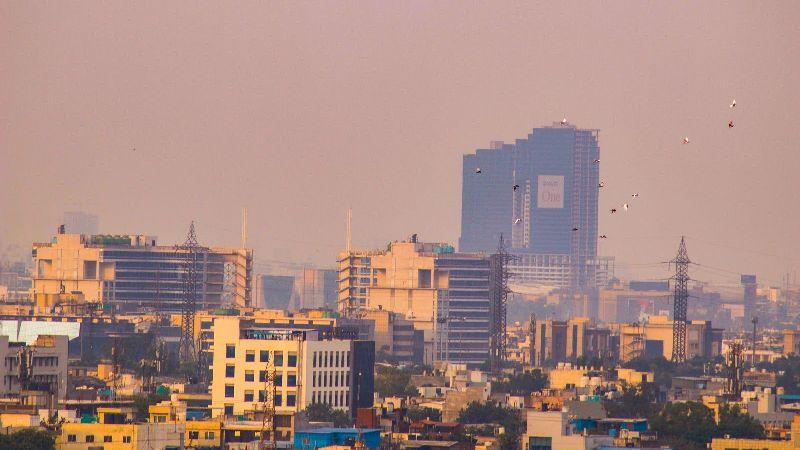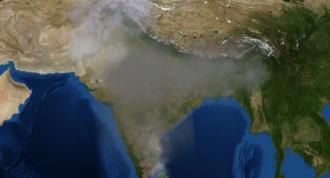
Photo by Anish Kumar
During days of extreme air pollution, tiny particles in the air bring down visibility. These particles called particulate matter (PM2.5) — measuring smaller than 2.5 microns in diameter — are emitted by sources such as power plants, automobiles, forest fires and cookstoves. In India, cardiovascular diseases and deaths caused by air pollution, including exposure to PM2.5, have rapidly increased over the years. Air pollution can also result in poor crop yields, and the future looks grim for most Indian cities. But, air pollution is not just an urban problem. Hence, policymakers need accurate knowledge of the concentrations of PM2.5 in the air across the country to take active steps towards lowering the emissions from regional polluting sources.
To devise such strategies, it is important to set up monitoring sites to measure the concentrations of particulate matter. But it is no easy task to figure out which locations make practical sense for these ‘regionally representative monitoring sites’ or RRMS. To narrow down the choices, it would require estimating the concentrations of particulate matter across the country for every 100 kilometres at the same time. This poses logistical and economical challenges. In the absence of such measurements over India, a new study by researchers in India has put forth an alternative method to estimate the concentrations across the country using satellite data.
The study was carried out by researchers from the Indian Institute of Technology Bombay (IIT Bombay), the Indian Institute of Science Education and Research Bhopal (IISER Bhopal), and the Indian Institute of Technology Delhi (IIT Delhi). Funded by the Ministry of Environment, Forest and Climate Change, Government of India, it was published in the journal Atmospheric Environment.
The researchers have used publicly available data from the National Aeronautics and Space Administration (NASA)’s Aqua and Terra satellites that send the gathered information to the ground stations twice every day. “The ease of data availability and the global coverage makes the use of satellite data an attractive supplement to ground-based measurements, especially where they are not available,” says Prof Ramya Sundar Raman from IISER Bhopal, the corresponding author of the study. They used this data to calculate the surface level particulate matter concentrations across the country. Although the method has limitations in accurately estimating surface PM2.5, so long as the trends are captured properly, deviations from actual surface PM2.5 values will not affect the outcome.
The researchers also collected local information from potential monitoring locations across the country, such as weather forecasts, wind patterns in the area that could affect the surface level concentrations of PM2.5, and ease of access from the site to central institutes for monitoring them. They used this information in tandem with the estimated PM2.5 concentrations to zero in on representative sites that were similar to their surrounding geographical areas in terms of factors such as topography, wind speed, and wind directions.
By comparing sites across the length and breadth of the country, the researchers finalised eleven sites: Sangareddy Road in Hyderabad; Mahabaleshwar; Delhi Road in Rohtak; Sector 81 in Mohali; Jaisalmer Road in Bikaner; Shallabaug in Srinagar, Shyamnagar near Kolkata; Pulibor in Jorhat; Mesra; Bahuri near Bhopal; and Mysuru. Amongst these sites, Shyamnagar and Bhauri represented their geographical neighbourhoods the most.

Locations of the regionally representative monitoring sites (RRMS). Image Credits: Nirav L. Lekinwala [adapted from Venkataraman et al. (2020) and Lekinwala et al. (2020)].
Before accepting a site as regionally representative, the researchers ensured that the results of the measurements were not affected by the peculiarities of the site itself. Thus, most of the sites are fairly distant from major sources of traffic and dusty unpaved roads as well as free of agricultural, industrial and domestic biomass burning, the researchers point out. The sites also captured the seasonal variations in particulate matter due to westerlies carried from the Mediterranean Sea, across the Arabian Peninsula, Arabian Sea, and the Bay of Bengal.
While some of the sites rated poorly compared to others due to topographic factors like hilly landmass, unavoidable proximity to industrial areas, absence of alternatives in the area, and socio-political challenges, they were the best pick for the region. For example, being close to heavily polluting industries can disturb the pattern of data obtained for the entire area. But, in sites like Rohtak, it is difficult to find a suitable RRMS that is not close to any industry.
Currently, PM2.5 measurements at the eleven regionally representative locations are underway and the data is being analyzed. “Filter-based PM2.5 samplers have already been deployed at the RRMS, and air sampling has been started,” says Prof Mani Bhushan from IIT Bombay, a co-author of the study. Detailed plans and schedules are in place for changing the filters of the measuring samplers and transporting them to the nearest chemical analysis lab.
The novel approach proposed in this study based on satellite data has been able to reduce human efforts and financial costs for setting up RRMS. Moreover, it has also provided a framework for locations across the world where ground measurements required for designing sampling networks are scarce. The researchers hope that the monitoring sites will be able to resolve the long-term need for monitoring the air quality.






